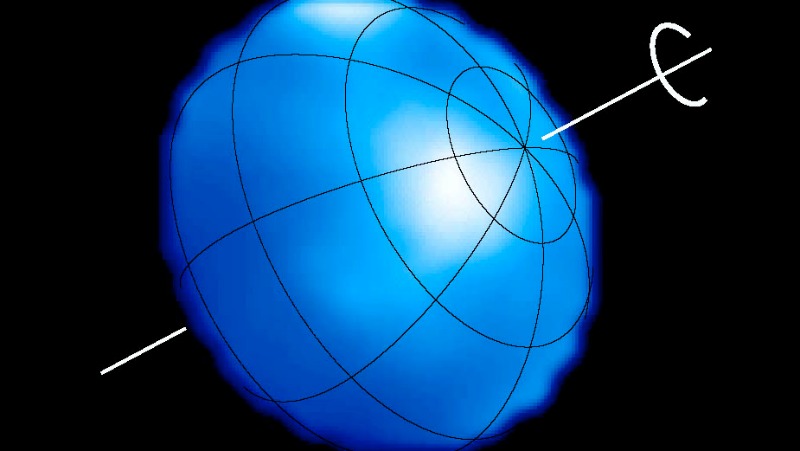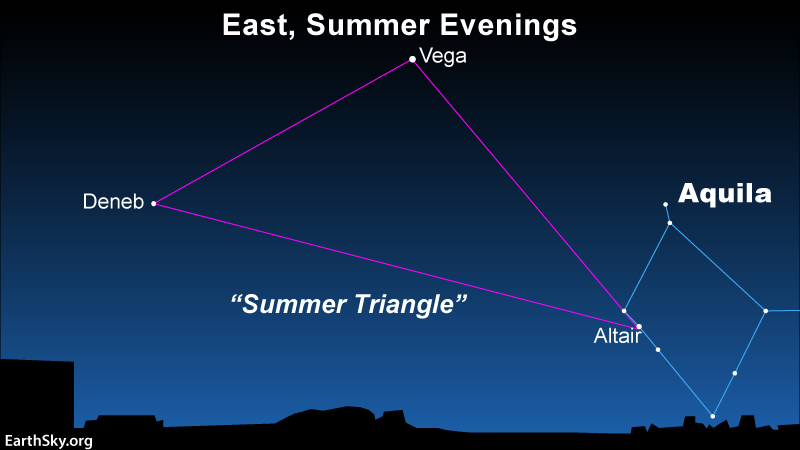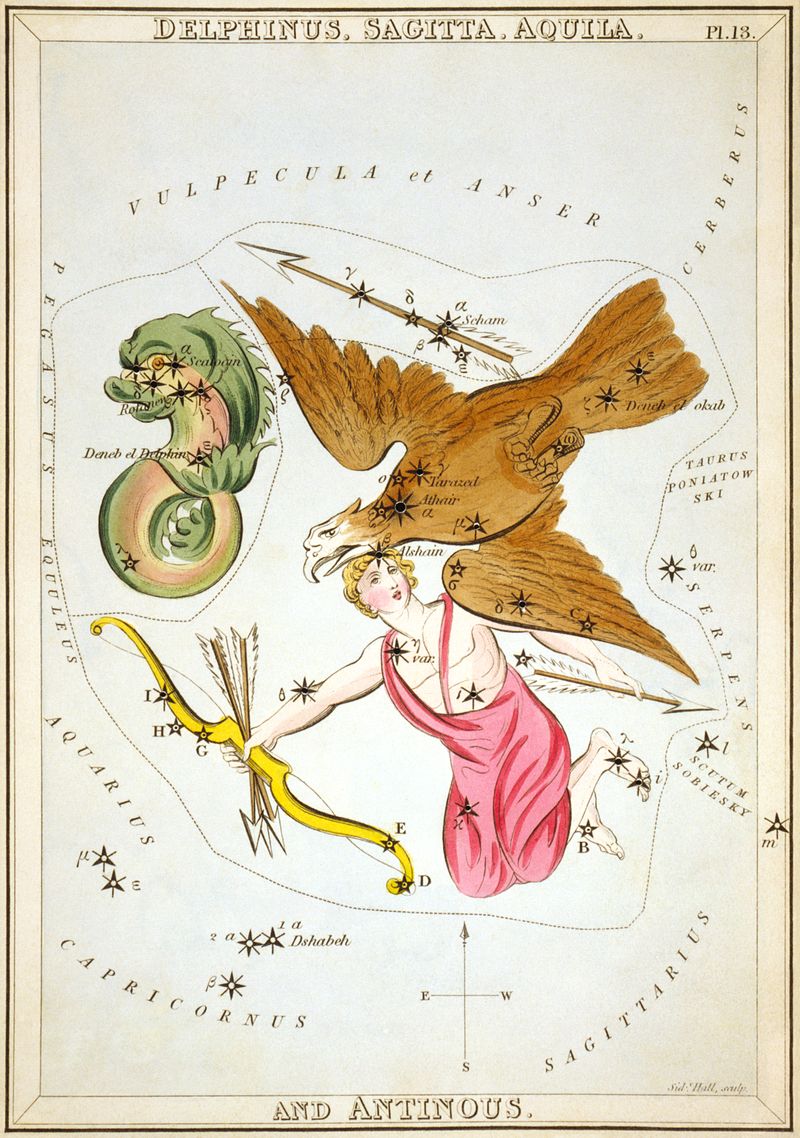
The bright star Altair, aka Alpha Aquilae, shines as the brightest star in the constellation Aquila the Eagle. Mostly known for being one of the three Summer Triangle stars, this star is distinctive in its own right. It’s only 16.8 light-years away from Earth, making it one of our nearest stellar neighbors. Plus, it has two more noteworthy features.
First, Altair rotates rapidly
This star requires only about 10 hours to spin once on its axis, in contrast to 24 hours for our Earth to spin once, and about 27 days for our sun. In other words, this mighty star spins on its axis more rapidly than Earth! This speedy spin tends to flatten the star a bit, much as a pizza crust flattens as it spins. Rough estimates are that Altair’s flattening is about 14%. Our sun is an oblate spheroid also, although its flattening is difficult to measure due to the low rotation rate.
In 2007, University of Michigan astronomers combined light from four widely separated telescopes to produce the first picture (above) showing surface details on Altair. The researchers, led by John Monnier of U-M, used optical interferometry to get this image. Read more about the study here.

Second, it’s variable – but not in a usual way
Variable stars brighten and dim, many on a (more or less) regular schedule. But Altair has as many as nine different rates of brightenings and dimmings. You won’t see these brightness variations with your eye. They’re too small to measure without sensitive instruments. But they’re there, and they’re likely related to Altair’s fast rotation.
By the way, if Altair took the place of our sun, at the distance the sun is now, life on Earth would be dooomed. That’s because Altair shines with 11 times as much visible light as our sun. As you might have guessed, Altair is a more massive star than our sun, with about 1.7 times the sun’s mass.
How to see Altair
Altair is our sky’s 12th-brightest star. Its apparent magnitude is about 0.76 or 0.77. So you can see Altair easily with the eye.
But how will you recognize it? If you’re outside on a July or August evening, watch for the large Summer Triangle pattern in the east (as shown on the chart above). Look near the horizon for Altair, the last of the three Summer Triangle stars to ascend over your horizon.
You will recognize Altair by the two fainter stars on either side of it. In her classic book “The Friendly Stars” (1907), Martha Evans Martin described the three this way:
Then there comes a soft June evening, with its lovely twilight that begins with the last song of the woodthrush and ends with the first strenuous admonitions of the whippoorwill; and, almost as if it were an impulse of nature, one walks to the eastern end of the porch and looks for Altair. It is sure to be there smiling at one just over the treetops, with a bright companion on either side, the three gently advancing in a straight line as if they were walking the Milky Way hand in hand and three abreast.
And indeed, the Great Rift of the summer Milky Way passes through the Summer Triangle, between the stars Vega and Altair. In dark skies in June, July and August, you can see rich star fields with your binoculars on both sides of the Great Rift.

“Forbidden Planet”
In modern western culture, Altair is probably best known for being the home star system of the aliens in the 1956 science fiction film Forbidden Planet.
Altair in history and myth
The name Altair is Arabic in origin and has the same meaning as the name of the constellation Aquila in Latin; that is, they both mean simply “eagle.”
In classical mythology Aquila, and by extension Altair as well, was an eagle favored by Zeus. He played a part in numerous myths, including the abduction of Ganymede in which Aquila carries off a young boy (Ganymede) to Mount Olympus on Zeus’ command to become the cupbearer to the gods. In another myth Aquila is the eagle that torments Prometheus, until Hercules shoots it with poisoned arrows.
In India, Altair with its two flanking stars, Beta and Gamma (Tarazed and Alshain), in tradition represent the celestial footprints of the god Vishnu.
Altair is separated from the similar looking (but brighter) star Vega in the constellation Lyra by the great starlit band of the Milky Way. In Asia, this hazy band across our sky is known as the Celestial River. One story common in China, Japan and Korea is of a young herdsman (Altair) who falls in love with a celestial princess (Vega), who weaves the fabric of heaven.
The princess became so enamored of the herdsman that she neglects her weaving duties. This act enrages the princess’s father, the Celestial Emperor, who decrees that the herdsman must stay away from his daughter, on the opposite side of the River. The Emperor finally listened to the princess’s pleas, however, and allowed the herdsman to cross the Celestial River once per year, on the seventh day of the seventh month.
In Japan, Altair is Hikoboshi, and Vega is Orihime (or Tanabata). If it rains on the day of the festival of Tanabata, the rain represents Orihime’s tears shed because Hikoboshi could not navigate the treacherous waters of the Celestial River.
The position of Altair is RA: 19h 50m 47.0s, dec: +08° 52′ 06″

Bottom line: Altair is the brightest star in the constellation Aquila, and one of the closest stars to our solar system. Although 1.7 times our sun’s mass, it spins on its axis in only about 10 hours.
Our Summer Triangle series includes:
Deneb is distant and very luminous
The post Summer Triangle star: Altair spins fast! first appeared on EarthSky.
from EarthSky https://ift.tt/3xwGv6Y

The bright star Altair, aka Alpha Aquilae, shines as the brightest star in the constellation Aquila the Eagle. Mostly known for being one of the three Summer Triangle stars, this star is distinctive in its own right. It’s only 16.8 light-years away from Earth, making it one of our nearest stellar neighbors. Plus, it has two more noteworthy features.
First, Altair rotates rapidly
This star requires only about 10 hours to spin once on its axis, in contrast to 24 hours for our Earth to spin once, and about 27 days for our sun. In other words, this mighty star spins on its axis more rapidly than Earth! This speedy spin tends to flatten the star a bit, much as a pizza crust flattens as it spins. Rough estimates are that Altair’s flattening is about 14%. Our sun is an oblate spheroid also, although its flattening is difficult to measure due to the low rotation rate.
In 2007, University of Michigan astronomers combined light from four widely separated telescopes to produce the first picture (above) showing surface details on Altair. The researchers, led by John Monnier of U-M, used optical interferometry to get this image. Read more about the study here.

Second, it’s variable – but not in a usual way
Variable stars brighten and dim, many on a (more or less) regular schedule. But Altair has as many as nine different rates of brightenings and dimmings. You won’t see these brightness variations with your eye. They’re too small to measure without sensitive instruments. But they’re there, and they’re likely related to Altair’s fast rotation.
By the way, if Altair took the place of our sun, at the distance the sun is now, life on Earth would be dooomed. That’s because Altair shines with 11 times as much visible light as our sun. As you might have guessed, Altair is a more massive star than our sun, with about 1.7 times the sun’s mass.
How to see Altair
Altair is our sky’s 12th-brightest star. Its apparent magnitude is about 0.76 or 0.77. So you can see Altair easily with the eye.
But how will you recognize it? If you’re outside on a July or August evening, watch for the large Summer Triangle pattern in the east (as shown on the chart above). Look near the horizon for Altair, the last of the three Summer Triangle stars to ascend over your horizon.
You will recognize Altair by the two fainter stars on either side of it. In her classic book “The Friendly Stars” (1907), Martha Evans Martin described the three this way:
Then there comes a soft June evening, with its lovely twilight that begins with the last song of the woodthrush and ends with the first strenuous admonitions of the whippoorwill; and, almost as if it were an impulse of nature, one walks to the eastern end of the porch and looks for Altair. It is sure to be there smiling at one just over the treetops, with a bright companion on either side, the three gently advancing in a straight line as if they were walking the Milky Way hand in hand and three abreast.
And indeed, the Great Rift of the summer Milky Way passes through the Summer Triangle, between the stars Vega and Altair. In dark skies in June, July and August, you can see rich star fields with your binoculars on both sides of the Great Rift.

“Forbidden Planet”
In modern western culture, Altair is probably best known for being the home star system of the aliens in the 1956 science fiction film Forbidden Planet.
Altair in history and myth
The name Altair is Arabic in origin and has the same meaning as the name of the constellation Aquila in Latin; that is, they both mean simply “eagle.”
In classical mythology Aquila, and by extension Altair as well, was an eagle favored by Zeus. He played a part in numerous myths, including the abduction of Ganymede in which Aquila carries off a young boy (Ganymede) to Mount Olympus on Zeus’ command to become the cupbearer to the gods. In another myth Aquila is the eagle that torments Prometheus, until Hercules shoots it with poisoned arrows.
In India, Altair with its two flanking stars, Beta and Gamma (Tarazed and Alshain), in tradition represent the celestial footprints of the god Vishnu.
Altair is separated from the similar looking (but brighter) star Vega in the constellation Lyra by the great starlit band of the Milky Way. In Asia, this hazy band across our sky is known as the Celestial River. One story common in China, Japan and Korea is of a young herdsman (Altair) who falls in love with a celestial princess (Vega), who weaves the fabric of heaven.
The princess became so enamored of the herdsman that she neglects her weaving duties. This act enrages the princess’s father, the Celestial Emperor, who decrees that the herdsman must stay away from his daughter, on the opposite side of the River. The Emperor finally listened to the princess’s pleas, however, and allowed the herdsman to cross the Celestial River once per year, on the seventh day of the seventh month.
In Japan, Altair is Hikoboshi, and Vega is Orihime (or Tanabata). If it rains on the day of the festival of Tanabata, the rain represents Orihime’s tears shed because Hikoboshi could not navigate the treacherous waters of the Celestial River.
The position of Altair is RA: 19h 50m 47.0s, dec: +08° 52′ 06″

Bottom line: Altair is the brightest star in the constellation Aquila, and one of the closest stars to our solar system. Although 1.7 times our sun’s mass, it spins on its axis in only about 10 hours.
Our Summer Triangle series includes:
Deneb is distant and very luminous
The post Summer Triangle star: Altair spins fast! first appeared on EarthSky.
from EarthSky https://ift.tt/3xwGv6Y

Aucun commentaire:
Enregistrer un commentaire